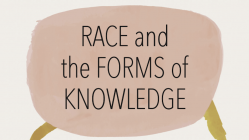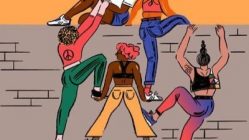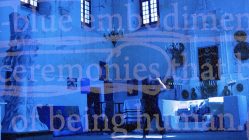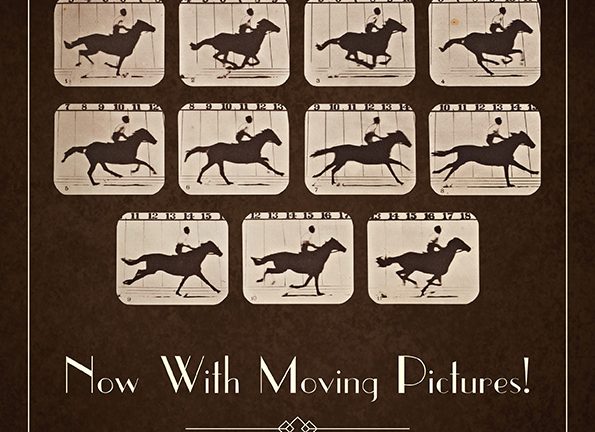[These talks were given on 8 February 2017 to launch the new Journal of Embodied Research. The transcript has been edited for clarity. For any quotations please use the written transcript version.]
Caroline Edwards, Co-Director, Open Library of Humanities
Hi everyone, thank you so much for coming. My name is Dr Caroline Edwards and I’m a Lecturer here in the Department of English & Humanities. My colleague Martin Eve and I are really delighted to be welcoming you to Birkbeck, which is the home of the Open Library of Humanities (OLH) – a publishing platform for open access journals in the humanities disciplines.
In 2013, we launched the OLH as a new kind of open access publisher. The idea was that we wanted to break away from many of the economic problems associated with paying for very expensive journal subscriptions. We wanted an academic-led, community-organized publishing platform of our own that we could be in charge of: one that is not for profit and runs as a charity. We launched the platform in September 2015 with eleven journals and now we publish eighteen journals, one of which is the Journal of Embodied Research.
We’re really pleased to be launching the Journal of Embodied Research with the editorial team tonight, particularly because it demonstrates the new digital possibilities of publishing online. We do quite a lot of computer programming and tech work on our platform and on the publishing front. It’s fantastic to be able to showcase a journal that really takes advantage of those opportunities that would actually not be possible in a print format. As someone who has a side interest in film and media studies, it’s always struck me how insane it is that the people working in these disciplines have to describe a scene from a film in written text. Doing close textual analysis of anything that requires video content is very difficult in print. So we’re delighted that the Journal of Embodied Research can forge a new direction for the study of performance by harnessing the opportunities that digital publishing provide.
And of course this journal is interdisciplinary. It covers all kinds of areas from film and television and media through to theatre and performance and also of course sport sciences, physiology, and arts practice and therapies and so on. It’s a great way to bring together these digital publishing opportunities with a very interdisciplinary kind of scholarly journal. Interdisciplinarity is something that we’re really keen on supporting at the Open Library of Humanities to help open up humanities journals to wider audiences beyond specific niche academic specialisms.
This evening we’re going to have some short presentations from some of the editors who are here with us tonight. First of all, let me hand over to Martin Eve, to welcome you.
Martin Eve, Co-Director, Open Library of Humanities
Hi, I’m Martin, I’m the other half. It’s very easy when you propose a new platform for publishing to think: Yeah, we’ll do that. We’ll put a load of our energy into something that is volunteerist, and then we’ll burn ourselves out in three years and be dead. So it was very important when we started that we came up with an economic model that could support this in the long term.
We now have 220 libraries around the world that are paying, year on year, to support Open Library of Humanities, and that includes Harvard, Yale, Princeton, Cambridge — big names — right down to small theological colleges in the States. This is designed to look like a subscription, but we make the work available so anyone can read it. We get both the benefits of open access and the benefits of the subscription model, without the disadvantages of either.
But this is also my cheeky plea! If you’re at an institution that does not yet support the Open Library of Humanities, please do consider asking your librarian. We’re very cheap. We are half the price of a single article from Taylor & Francis per year on an open access basis. And we can do a lot more that work on a charitable basis than an organization that makes 38% profit. So if you support what we’re doing and you want this journal to thrive, please do consider going to your libraries. That’s all I’m going to do on the sales pitch, thank you very much.
Ben Spatz, Editor, Journal of Embodied Research
Thank you so much. I’m extremely honored to be here and to be speaking about this new journal.
I want to say first thank you to the two of you for making this incredible venture, the Open Library of Humanities. As I was developing the idea for this journal and going through the steps of thinking, well, it has to be video articles and it has to be open access, and I started to shop it around, the economics were impossible in the places that I looked. And it led me to think, there’s a really substantive question here: What funding model could work? Who should be funding the open access journals of the future, now that there’s a huge movement towards open access publishing for scholars, for researchers. There’s a huge motivation to shift and to flip journals. How can this be solved? I have no idea, this is not my field, I don’t know — and then suddenly I discovered that some people had come up with a brilliant alternative funding model that uses the resources that exist and creates a constituency of libraries to fund this kind of work. I think it’s just extraordinary. So I was very honored and pleased to go through that process and have the journal approved.
Let me say a few words about the journal. There’s so much to say and in a way my thoughts about the journal are already contained in the submission guidelines. Usually submission guidelines are not so substantive, they’re kind of the same for most journals, but this is a set of submission guidelines where there was a lot of thinking and sweating… And it was shared with the Editorial Advisory Board, which is a very wonderful and illustrious group of people, who gave feedback on it. So there’s a lot of thinking in the submission guidelines, but it remains speculative. [laughter] It’s the best that we collectively could put forward in terms of what we think should be governing guidelines, but there’s quite an open field here.
Let me point to some hidden histories of the relationship between video and embodiment. I put this montage up, which I’ve been using for many years to point towards the field of embodied practice and specifically embodied research. Not only are we seeing here four very different embodied practices, but we’re also seeing something close to the origin point of four areas of embodied practice, four areas of embodied knowledge, which are still taught today by many, many people who are not the practitioners pictured in the videos. So you can see here not just really interesting practices but research moments, moments of research where knowledge was generated about possibilities, things that you can do with your body, with bodies, which then has gone around and circulated and had much, much wider effect than probably could have been imagined by the individuals who are pictured here. That I think is very important in thinking about these fields of embodied practice as ongoing, as continuous, as continually branching and developing and changing.
Let me mention three points of appearance of embodied knowledge circulating through video. In the founding document by Marcel Mauss on embodied technique, he talks about how ways of walking moved from the US over to Europe through film. And those aren’t anthropological documents of how people walked, they’re just movies: regular movies, which intended to be about plot and character and whatever else, but encoded in them somehow was ways of walking. And he noticed that that was being transmitted. It’s like a secret history.
I was at the Tate Museum this afternoon and I saw an installation about performance art. It was referring to the famous film of Jackson Pollock making his paintings, where again the thing that was important at the time, the thing that would have been the ostensible focus, was the painting itself, the art object, the item that then emerges and is sold for thousands of dollars. But in fact the video had a huge impact because it was about the embodied practice that was leading to that painting and it helped displace the location of meaning off just the physical object of the painting itself and onto the embodied practice and the embodied knowledge that was creating it.
And then this morning there was an article in the Guardian talking about YouTube and vlogging, which is such a very hot topic. The vlogosphere is exploding. It’s been exploding and it has developed extremely dynamic modes of intertextuality or intervisuality where people make a vlog and someone else makes a vlog in response to the vlog and someone quotes the vlog and there are these kinds of circulations. But that kind of dynamic use of video is not really emerging so much yet in academia, it seems to me, although it’s starting in a number of different fields. And I hope that this journal will be a space to hold some of those new possibilities.
Let me finish by asking: What is our responsibility? I think that, particularly now, I’m feeling very much that although it’s essential to underscore the purely epistemic dimension of embodied practice, I personally cannot stop there anymore because the politics of it are also palpably urgent, increasingly palpably urgent. In thinking about how to think about the politics of embodied knowledge and the politics of video epistemology for embodied practice — how to think about those politics without reducing the deep, epistemic dimension of the practice — I’ll mention two things.
One is the epistemological diversity of the space that can be created through this journal. I won’t even attempt to list in any kind of way what that epistemological diversity could include. I think it’s clear in the description of the journal that there’s a kind of disciplinary mapping of fields that have been engaged with embodiment, which is all over the humanities and all over the social sciences. It includes clearly the performance fields and theatre and dance but also clearly includes the crucial work on embodiment that’s been done in gender studies, in queer studies, in critical race studies, in indigenous studies — and all of those are linked to embodied practices, which means they’re also linked to embodied knowledge. And some of the responsibility I think is to really think: What does epistemological diversity mean and how to we really mobilize new communities and new constituencies around that?
The other thing that I’ll mention is something about the way that authorship is configured, which also includes the practices of citation in the videos. Practices of citation is a concept from Sara Ahmed, it has to do with the politics of citation. I’ve already been speaking with some people about possible submissions and thinking about what will be the authorship structure. Because one of the key elements in the speculative submission guidelines is that embodied practitioners whose work is documented in the video articles should be understood as authors. What does that mean? It’s a big question, but it’s certainly a change from the traditional modes of theatre scholarship, performance scholarship, anthropology, in terms of the relationship to the embodied practitioner. If we understand the embodied practitioner as absolutely central to the research itself, and not just the object of the research, that’s going to change the structure of authorship and the structure of citation in ways that we can’t predict.
So all of these are questions, which the journal is then an open field to really be hashed out through back and forth, and through peer review, which I think is crucial. Interdisciplinary peer review is a really exciting place to hash out these questions.
With that in mind, I’ve invited two of the Editorial Advisory Board members, who are coming from very different perspectives than me and than each other, to talk a little bit about their hopes and thoughts about the journal.
Royona Mitra, Editorial Advisory Board, Journal of Embodied Research
Thank you, Ben. I want to start by saying I think it’s absolutely crucial and timely that such a platform for scholarly work has been created. Well done Ben, for getting us here. I’m really honored to have been asked to join the Advisory Board. When Ben asked me to become part of this really exciting platform, what struck me about it is the essays as video submissions.
As an Indian dance scholar, I have always dealt with knowledge that has been passed on through generations, through oral traditions, and through embodied means. So the need to write down what that knowledge is, in order to validate it, has always been something that I’ve struggled with. From my perspective it’s been a colonizing, western perspective on knowledge transmission. This opportunity opens up the possibility of decolonizing that trajectory. But with that comes a kind of democratization of who speaks and how they speak, a level of openness about the possibilities that this medium offers.
With another hat on, as a co-editor for the ‘Training Grounds’ section of the Theatre, Dance and Performance Training journal — which is specifically designed for engaging practitioner voices within an academic journal — I often come across this: Practitioners, no matter how much we say to them that we want writing in different modalities, we want voices to be creative, they are still restrained by the fact that they’re having to write. Somehow that in itself becomes a limiting factor for how they can articulate. I think this offers an opportunity to really democratise the process of who speaks, how they speak, what medium they speak in.
Now, as a dance scholar, the very principle and practice of embodied research is not new. It is at the heart of what we do. But I want to, on the Advisory Board, offer the possibility of thinking about embodied research in a different way. For this I think my positionality as a brown Indian scholar within the UK context is vital. I just want to reflect on that for a second: To me, embodied research is driven by minoritarian embodied realities which become both the source and the subject of dance scholarship. And I don’t think I’m alone in thinking this way. Dance scholar Melissa Blanco Borelli echoes this very thought in her book She is Cuba: A Genealogy of the Mulata Body. I quote: ‘Ultimately this is a project about the construction of subjectivity: the historical mulata and my own’.
Blanco Borelli’s recognition of this collapse between the self and scholarly subject matter is very much the starting point of my own embodied dance scholarship. This lends us embodied scholars an insider/outsider lens through which we can engage with the subject of what we write about. But there’s something more than that. I think for the longest time, minority realities and voices have been written about by others, those outside those realities. What I look at through the possibility of this medium is a way of writing ourselves.
For example, when I was writing my book on Akram Khan, the British-Asian dancer-choreographer, one of the things that I was certain was going to make my contribution different to how other scholars had already written about him — although mine is the first monograph on the artist — was the embodied position from which I could talk about his work. We’re both British Bengali first and second generation subjects respectively. We both trained in kathak and then went on to train in contemporary western dance forms. We’re both in interracial marriages. We both have children with mixed race heritages and multicultural heritages. These are not simple and superficial facts that bind us together. In fact, these overlaps leant me ways of seeing his art that perhaps was not visible, not palpable, to people coming at it completely from the outside. Like Blanco Borelli, I made this self-investment very clearing the preface to my book and I laid out the intersecting embodied realities between us. My positionality vis-à-vis Khan’s art-making is vital to the ways in which I’ve been able to theorize his work.
As an Advisory Board Member for this journal, I’m committed to expanding our understanding of what embodied research could mean. Of course it means practice-driven work which we’ve all been celebrating and championing for such a long time within performance studies, where research questions are worked through embodied means. But I also want it to mean more complex modes of enquiry where the relationship between the enquirer and the enquiry merges, such that the scholarship can emerge from the very tensions which are generated at the interstices between being an outsider and an outsider to the subject of study. And then when you throw into the mix the modalities of what this digital platform can offer to these enquiries, the possibilities are endless, mind-boggling, still to be discovered, and frankly game-changing.
Paul Bowman, Editorial Advisory Board, Journal of Embodied Research
Thank you very much. I’m delighted to be involved, thank you to Ben. I’ve been asking myself why it would be me who would be involved because I come from a very text-based, very logocentric world: English literature, visual cultural studies, political theory. But recently I’ve been involved in the development of what we’re now calling martial arts studies.
Martial arts studies has a peculiar problem with texts, with the written text. The written text always seems to call out for more. So if you’re doing historical martial arts studies you look at the historical texts, and that text seems to demand the production or the generation of some kind of embodied knowledge. Literary texts, logocentric texts lack something and what they lack is the body. And there have been lots of different attempts to generate this knowledge. There’s a movement called Historical European Martial Arts (HEMA) and it’s kind of like a battle reconstruction. They will have these ancient documents and they try to embody it and it’s riven with problems but extremely interesting.
There’s lots of different texts that structure the field of martial arts research and they’re all different. You go from the historical training manual, the historical Chinese training manual, and try to imagine what that would have looked like, through to really bizarre texts like films. And nowadays — as Ben began by talking about Marcel Mauss and the transmission of ways of walking through films — films also transmit what people believe fights are like. So in the ‘70s we started to believe that fights involved huge high kicks, and subsequently we believe they involve grappling and all different things… Even the most kind of hyperreal — what Baudrillard would call hyperreal, the hyperreal martial arts cinema, the Bourne Identity, the James Bond — these have real effects in the real world on people’s bodies.
I also think it’s particularly interesting — the first conversation that Ben and I ever had was about the invention of ways to learn and study embodied knowledge and embodied skill. It’s interesting that what the proposal is is that it’s through video, through visual media. Baudrillard thought we’re losing the real through audiovisual media. What Ben is proposing and what we’re all working on here is kind of having a new relationship with the real, mediated through films. I think that’s really important.
I feel like a kid in a candy shop, to be invited into this world and to help work this out. I think that one of the very interesting things about this is that there’s a kind of catch-up going on here because the academic world is still very logocentric. Peer-reviewed, rigorous scholarship has to be words — or algebra. It has to be written down. And we’re existing now in a state of denial in relation to what is very obviously a post-literate world that we live in. My children can’t spell, but they can make their own music videos. That’s the world that we live in, it’s post-literate. And also the things that we do on a day to basis. If I do a lecture, my aspiration for the lecture is that it would be as good as a documentary. We use Prezi and we show video clips and everything, because the academic world is being hegemonized, being supplanted by audiovisual technology. And my students, they want me to video the lecture as well. They’ll turn up, which is nice, but then they want to watch it again, because that’s somehow more real than the real. Oh god, I am Baudrillard!
Audiovisual has, in most contexts, displaced the hegemony of the written word. I think that one day we’re going to see the video journal, or something like it, as the norm. But even if this happens, it doesn’t diminish the unique work of the Journal of Embodied Research that is yet to happen. I think that it’s blazing a trail, it’s posing these problems and proposing new ways of exploring and learning and then teaching from that, and legitimating different types of knowledge. And it’s engaging with lots of problematics of how do you capture, how do you communicate, how do you validate, how do you legitimate things. I think that a great deal of journals that come after will be indebted to the Journal of Embodied Research. So I’m completely honored and delighted to be part of this, and much as I am a child in these waters, I’ll do my best to try and help flesh out the parameters of this new field.








[…] These following talks were given on 8 February 2017 to launch the new Journal of Embodied Research. The transcript has been edited for clarity. To hear the audio recording, please visit the original post. […]